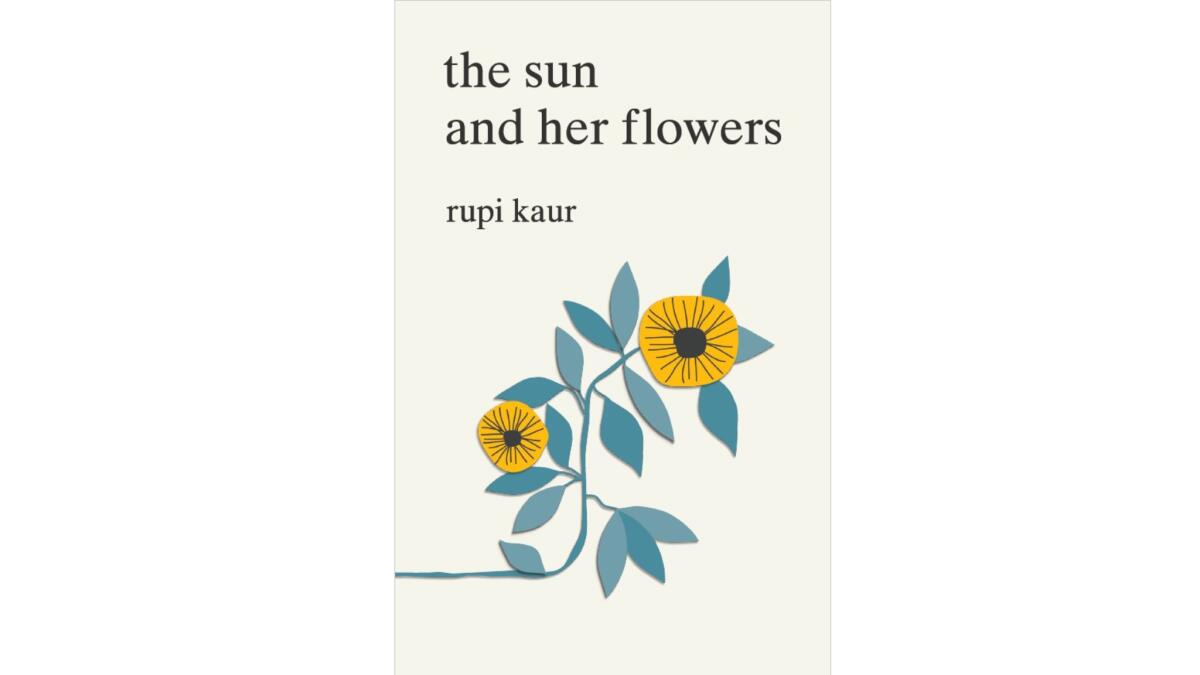Instapoet Rupi Kaur may be controversial, but fans and book sales are on her side
“Milk and Honey,” the debut collection by 25-year-old Canadian poet Rupi Kaur, is the top-selling book in the United States this year so far, but its competition may have finally arrived — in the form of Kaur’s second book of poetry, “The Sun and Her Flowers” (Andrews McMeel, $16.99.)
Kaur is a leader in the new movement of writers known as Instapoets, due not, as some might imagine, to instantaneous careers or fame, but because they have grown substantial readerships by sharing their poetry on Instagram.
As of this writing, Kaur has 1.7 million Instagram followers, including pop star Ariana Grande (two days ago it was 1.6 million). When Kaur revealed the cover art for “The Sun and Her Flowers” on her account in July, the post received 180,138 likes and 8,044 comments, some of which (“OMGGG YASSS!!!” “I love you, rupi!”) recall the fervent devotion of Beatles fans.
“Even yesterday, so many people were showing me love at our reception,” she said of the book’s launch when we spoke recently. “I was so grateful and feeling so blessed, but at the same time, I was like, this is so confusing. Poetry? Really?”
Rupi Kaur performs at the Aratani Theatre on Oct. 19 at 7:30 p.m. »
Kaur lives in Toronto, where she moved from India with her family when she was 4. She studied English at the University of Waterloo in Ontario and performed her poetry live in Canada before she began sharing it on social media.
Kaur’s poems, which appear in a single Instagram image, are often brief (“on the last day of love / my heart cracked inside my body”). Themes include collective and personal trauma, migration, female empowerment and love lost. “While everybody else is saying, ‘We’re not going to publish this because no one wants to read poetry about domestic violence,’ or so much of what ‘Milk and Honey’ was…social media allowed me to find the readers,” Kaur said.
She self-published “Milk and Honey” in 2014 and its impressive sales figures landed a two-book deal with publisher Andrew McMeel, which re-released it on a wider scale. It was a smart business decision: Since its release “The Sun and Her Flowers” has been vying for No. 1 on Amazon, along with Dan Brown’s novel “Origin” and John Green’s “Turtles All the Way Down.”
Poetry — especially if it’s short, emotive and direct — is surprisingly suited to Instagram. Kaur often accompanies her poems with illustrations. She also works in other visual media — photography, art direction — and like fellow Instapoets r.h.sin and Lang Leav, weaves photographs into her feed.
A poem by Kaur that reads “fall / in love / with your solitude” is immediately digestible. Like an image of a friend’s face or a beautiful sunset, it arrives as a comforting affirmation while alone in bed, scrolling your phone.
“A lot of my readers online are younger,” Kaur said. She isn’t bothered by the label Instapoet, but said that because her popularity grew from Instagram, some readers will always dismiss it out of hand. “I think it comes from this lack of understanding and this fear of the new. Because you have a form of art that is so traditional, which is poetry, and then you have something that is so new and nontraditional, people are still trying to figure out, which is social media.”
Poet and critic Matthew Zapruder, author of the book “Why Poetry,” doesn’t criticize the delivery system, but says Kaur’s work rejects traditional poetic qualities. “All the things that we think of as important in poetry and in literature in general, it’s not present in her work. It’s not complex,” he said. And yet, he said, this very quality may be what allows it to connect with so many readers. “It’s devoid of the particularities of personality… It is a kind of genius, in a way, to pick the things that almost everyone could recognize in their lives.”
As befits popularity on Kaur’s scale, her work has also drawn controversy. Buzzfeed critiqued her as a “self-appointed spokesperson of South Asian womanhood” who is “a privileged young woman from the West.” Parody tweets and Instagram posts mock Kaur’s poetic style. For every fanboy, there is a troll, but it is rare to see a poet debated so vehemently on social media, perhaps because it is rare to encounter a poet so much a product of that particular space.
Kaur made headlines in 2015 when Instagram removed a photograph she posted depicting a menstrual stain. She fought back, responding that objectification of women is rampant on the platform, and that she was trying “to demystify the period and make something that is innate ‘normal’ again.” Instagram later apologized.
“Good art will always break boundaries, and that’s what the gatekeepers are also seeing,” Kaur told The Times. Kaur composed the work in her first collection “entirely for me, with zero concept of book in mind” but she sees “The Sun and Her Flowers” as “one long continuous poem that goes on for 250 pages,” which while birthed in Instagram, is a concept that depends on being bound.
Former Poet Laureate of California Carol Muske-Dukes said that like Kaur, she has written about women’s issues — her next book, “Blue Rose,” is due in April — but “I reach a couple thousand people and she reaches millions. I say more power to her.”
In Kaur’s work, she sees the continuance of a tradition. “Rupi is a ‘performative poet.’ You see the performative on the stage — let’s say Instagram — and then on the page it enacts itself in the mind.” She noted that “Kaur is being mocked by critics and poets who seem to believe that if poetry is accessible it’s dismissible,” and suggested those detractors “take a page from Kaur's book. She’s showing you don’t have to be part of an aesthetic war to write poems that reach people.”
Kaur’s work is inextricable from its medium, which is still in its infancy: the Instagram poem. It’s the leap from that medium to literary stardom that seems to rankle. But she doesn’t need the establishment’s stamp of approval; she’s earned legions’ approval for herself.
After all, while her Instagram account may boast 1.7 million followers, in the ultimate social-media power move, Kaur follows no one.

Sign up for our Book Club newsletter
Get the latest news, events and more from the Los Angeles Times Book Club, and help us get L.A. reading and talking.
You may occasionally receive promotional content from the Los Angeles Times.




